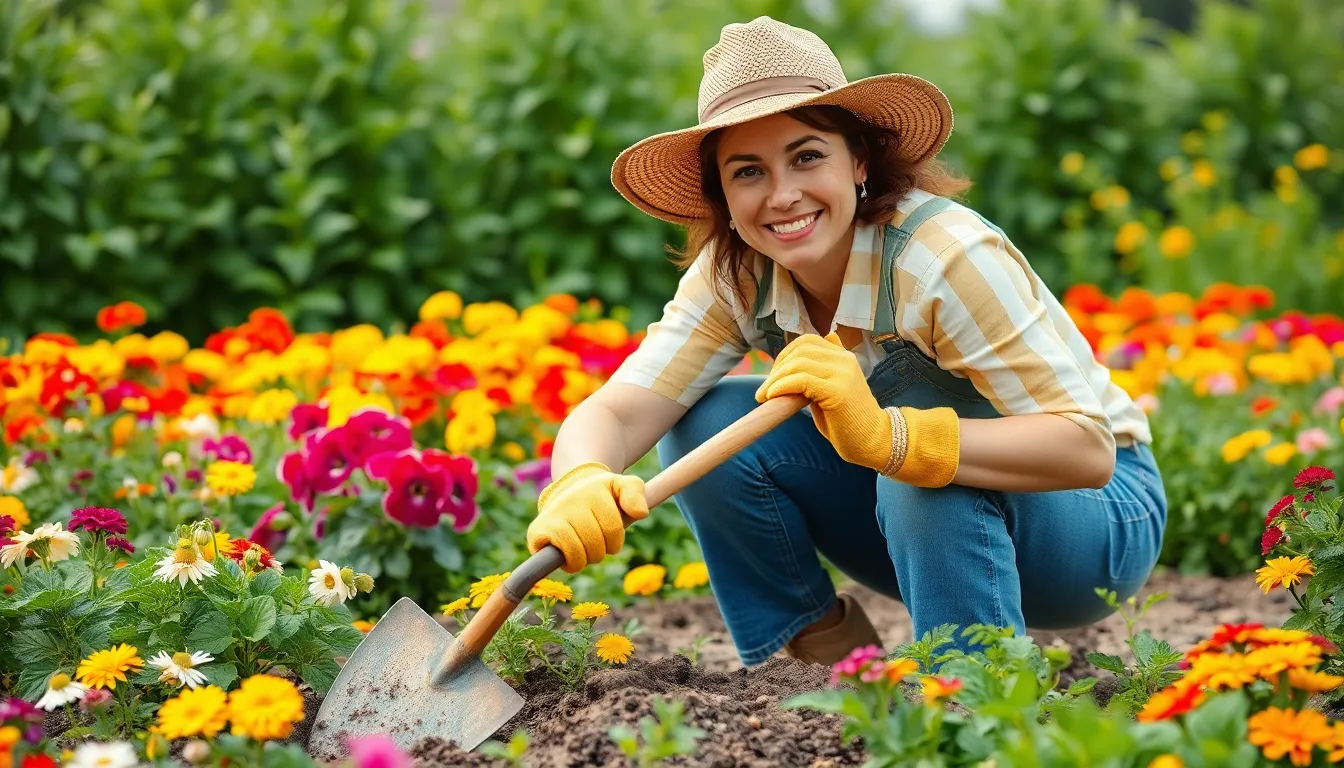In the world of gardening, the hoe is the unsung hero, often overshadowed by flashier tools like the shiny tiller or the trendy spade. But let’s face it: without this trusty companion, those pesky weeds would take over your garden faster than you can say “green thumb.” Whether you’re a seasoned gardener or just starting out, the hoe is your secret weapon for cultivating a thriving outdoor space.
Overview Of Hoe Gardening Tool
The hoe serves as a fundamental tool in gardening, primarily designed for breaking up soil and removing weeds. Gardeners often use it for tasks like cultivating soil and creating furrows for planting seeds. Various hoe types exist, including the traditional garden hoe, the stirrup hoe, and the broadfork, each tailored for specific gardening needs.
Different gardeners choose hoes based on their particular tasks. A traditional garden hoe features a flat blade, effective for digging and turning soil. The stirrup hoe, with its distinctive shape, efficiently removes weeds by cutting through the soil. A broadfork allows deep aeration of the soil without turning it over, preserving beneficial organisms in the process.
Using a hoe requires proper technique to maximize effectiveness. Starting with a firm grip, gardeners perform short, swift motions, allowing the blade to slice through the soil and weeds. Regular maintenance, such as sharpening the blade, enhances performance and extends the tool’s lifespan.
Integrating a hoe into gardening routines fosters healthier plant growth. By controlling weed populations, the hoe reduces competition for nutrients. Additionally, breaking up compacted soil promotes better root development for vegetables and flowers.
Understanding hoe varieties and techniques empowers gardeners to optimize their gardening efforts. An effective hoe enhances not only the appearance of a garden but also its productivity, making it a vital tool in both small and large gardening endeavors.
Types Of Hoe Gardening Tools

Different types of hoe gardening tools exist, each fulfilling specific gardening needs. Understanding these variations helps improve gardening efficiency.
Traditional Hoes
Traditional hoes consist of a long handle and a flat blade. Features include a sharpened edge for cutting through soil and weeds. Gardeners use these for tasks like planting and weeding. Popular models include the draw hoe and the stirrup hoe. The draw hoe works well for cultivating soil; it allows gardeners to break up clods effectively. In contrast, the stirrup hoe excels at slicing through weeds just below the soil surface.
Modern Hoes
Modern hoes incorporate advanced designs and materials. Features such as lightweight materials and ergonomic handles enhance usability. Some models include the oscillating hoe, designed for quick weed removal without disrupting surrounding soil. Others feature adjustable heads for versatile applications. Gardeners may find plastic or composite materials in modern designs, offering durability and resistance to rust. Innovations ensure that modern hoes remain functional even with extensive use.
Choosing The Right Hoe Gardening Tool
Selecting the appropriate hoe gardening tool involves considering various factors that influence performance and comfort.
Size And Weight Considerations
Size and weight significantly affect hoe usability. A lightweight hoe enables prolonged use without fatigue. Shorter handles suit smaller gardeners or confined spaces, while longer handles provide leverage for larger gardeners and more expansive areas. Opting for a tool that balances well ensures control and efficiency during tasks. Gardeners usually prefer a hoe that feels comfortable, allowing them to maintain a proper grip for extended periods.
Material Options
Material also plays a vital role in hoe selection. Steel blades resist wear and provide durability, making them ideal for tough soil. Some hoed feature stainless steel for added corrosion resistance, while others use carbon steel for lightweight handling. Handles made from hardwood offer strength and longevity, whereas fiberglass options reduce overall weight without sacrificing sturdiness. Choosing a hoe with the right material combination enhances functionality and gardening experience.
Proper Use And Techniques
Using a hoe effectively requires specific methods for optimal results. Gardeners can utilize different techniques to maximize the hoe’s potential in managing weeds and preparing soil.
Effective Weeding Methods
Weeding becomes simpler with the right hoe and techniques. A stirrup hoe glides easily through the soil, slicing weeds just below the surface. Employing a swift, back-and-forth motion allows for quick weed removal while minimizing soil disturbance. Focus on recurring areas where weeds sprout frequently to create a more effective weed management routine. Timing is critical; tackling weeds early prevents them from establishing roots. Regularly checking for new growth ensures healthy garden maintenance.
Soil Preparation Tips
Preparing soil properly enhances garden productivity. Start using the draw hoe to break up compacted soil, making it easier for roots to penetrate. Apply downward pressure and pull the hoe toward the gardener to create a fine seedbed. For larger areas, consider using the oscillating hoe for faster results without significant soil upheaval. Assess soil moisture before tilling; damp soil is easier to work with. Incorporating organic matter during the process enriches the soil, fostering healthier plant growth.
Maintenance Of Hoe Gardening Tools
Maintaining hoe gardening tools ensures longevity and efficiency. Regular cleaning after use prevents soil and debris buildup. Rinsing the tool with water followed by thorough drying helps avoid rust formation.
Inspecting the hoe for any signs of wear is crucial. Checking blades for dullness determines if sharpening is necessary. A sharp edge enables better weed cutting and soil turning.
Storing hoes properly preserves their condition. Keeping them in a dry area prevents moisture damage. Hanging tools on a wall or keeping them in a designated storage bin promotes organization and easy access.
Lubricating wooden handles maintains their integrity. Applying mineral oil periodically prevents splintering and keeps the wood in good shape. Furthermore, checking for loose parts ensures everything remains securely attached, preventing accidents during use.
Maintaining a consistent schedule for these tasks enhances the tool’s performance. Following a bi-annual inspection routine helps identify issues early on. Doing so ensures that the hoe remains ready for use whenever needed.
Replacing damaged or heavily worn hoes is also important. Investing in a new hoe guarantees optimal functionality and reduces frustration during gardening tasks. Understanding these maintenance practices allows gardeners to maximize the benefits of their hoe gardening tools, ensuring effective use for years to come.
Conclusion
The hoe remains an indispensable tool in any gardener’s arsenal. Its versatility in managing weeds and preparing soil cannot be overstated. By selecting the right type of hoe and employing proper techniques, gardeners can enhance their efficiency and achieve a thriving garden. Regular maintenance ensures that this essential tool remains effective and ready for use. Embracing the hoe’s simplicity and functionality allows gardeners to cultivate healthier plants and enjoy a more productive gardening experience.




